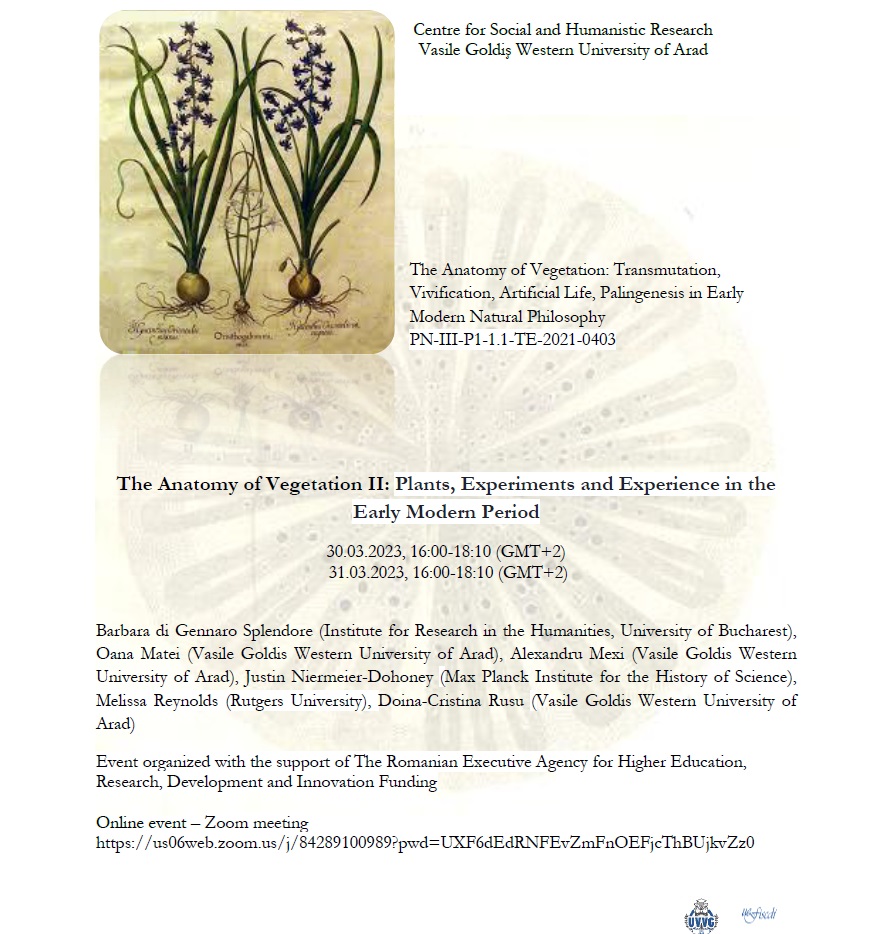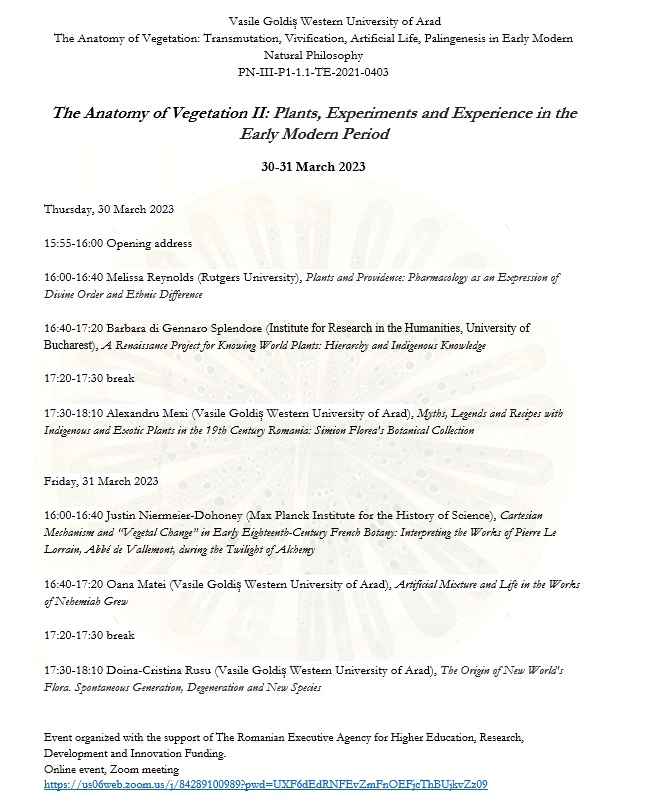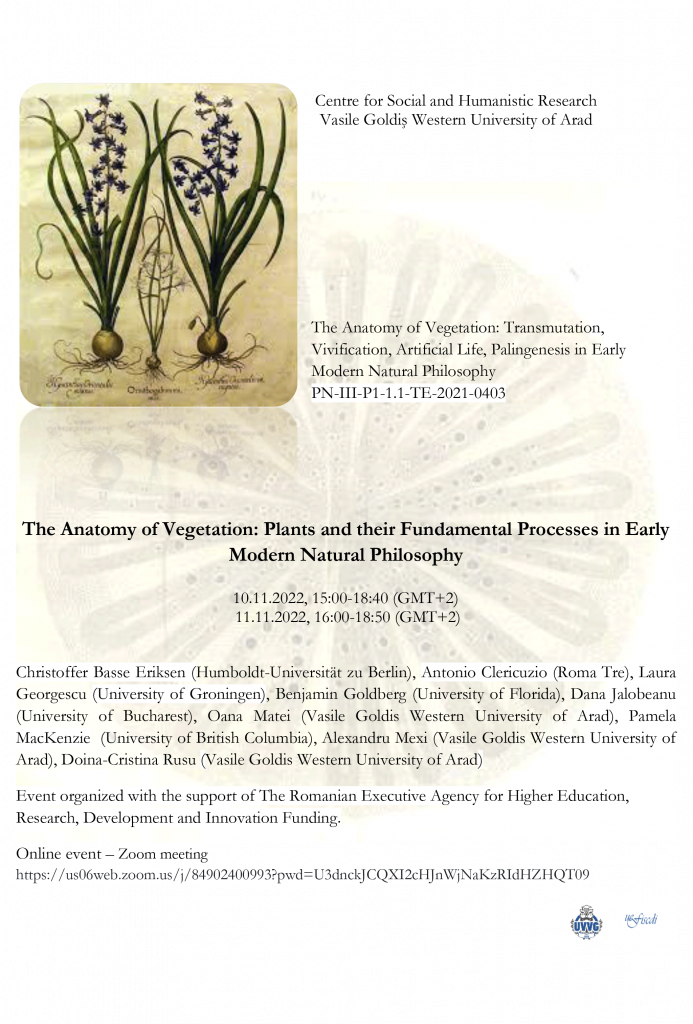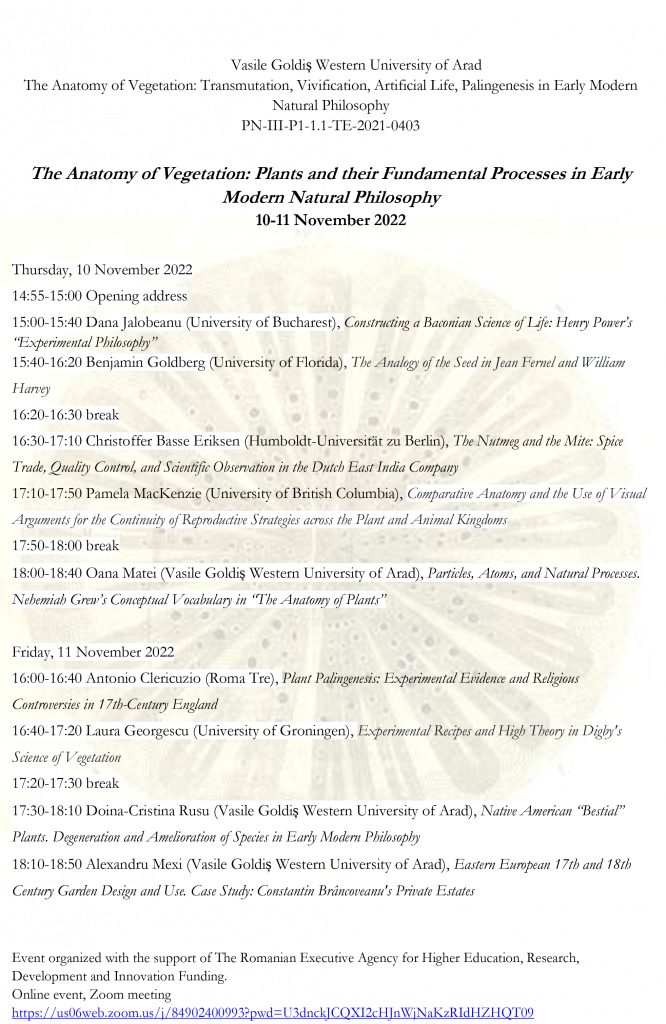

Plants and Providence: Pharmacology as an Expression of Divine Order and Ethnic Difference
Melissa Reynolds
Rutgers University
Late medieval, vernacular English herbals and recipe collections abound with directions for harvesting and preparing medicinal plants to heal various ailments. These directives often borrowed from Latin herbaria that integrated elements of the Galenic theory of degrees within a medieval Christian worldview: the elemental qualities of hot, cold, wet, or dry became “virtues” that God had endowed within natural matter for the express purpose of healing mankind. Drawing on examples from Middle English herbal manuscripts, in this paper I show how belief in the divine order of nature shaped late medieval English healers’ knowledge of medicinal plants. Moreover, I demonstrate that these beliefs survived the upheaval of the Reformation to take on new life in the sixteenth century in the writings of Timothy Bright, a later-sixteenth-century English physician and devout Protestant. Bright’s A treatise: wherein is declared the sufficiencie of English medicines (1580), advanced a radical new theory of ethnic and racial difference premised on a perceived relationship between plants, providence, and human bodies.
A Renaissance Project for Knowing World Plants: Hierarchy and Indigenous Knowledge
Barbara Di Gennaro Splendore
Institute for Research in the Humanities, University of Bucharest
In the sixteenth century naturalist Ulysses Aldrovandi conceived a grandiose project for creating and stabilizing knowledge about world materia medica. Such a project was global in geographical scope and envisioned the systematization of indigenous knowledge from all over the world by European scholars, with a centralized organization. His project was universal, comprehensive and hierarchical. I discuss this imagined project in its main tenets concentrating on the place he accorded to indigenous knowledge in the enterprise. Such place has to be considered also in comparison with what Alex Cooper named the “invention of the indigenous,” the rediscovery of local natural resources in Central and Northern Europe. I argue that Aldrovandi based his appreciation for indigenous knowledge on a long-standing tradition of “reasoned experiences.”
It is worth noting that, Aldrovandi apparently overlooked, or undervalued, a more informal, collaborative, and spontaneous enterprise to create universal knowledge which was emerging under his very own eyes and within the network of naturalists he was part of. The business of creating new natural knowledge was messier than the one Aldrovandi envisioned.
Myths, Legends and Recipes with Indigenous and Exotic Plants in the 19th Century Romania: Simion Florea’s Botanical Collection
Alexandru Mexi
Vasile Goldiș Western University of Arad
By the mid- and end of the 19th century, Simion Florea Marian, a local priest from Suceava, folklorist, ethnographer, naturalist, historian, teacher, and member of the Romanian Academy, started collecting plant myths, legends and recipes from all over the North-Balkan region, a vast area encompassing nowadays territories of Romania, Hungary, Serbia, Bulgaria, the Republic of Moldavia and Ukraine. He named his collection “Botanica Poporană Română” (tr. The Romanian Popular Botany) and although he collected a huge material which is now listed as movable cultural heritage, little research has been conducted on it. To this end, the following presentation aims to present the collection, its original sources and some of its most interesting documents, focusing on those materials referring to myths, legends and/or recipes involving exotic plants such as coffee, cloves, liquorice etc. The paper also aims to compare Simion Florea Marian’s list of plants with those of important private gardens, public parks and botanical collections of the time in order to see if some of the exotic plants from his collection were found and used in the region or they were know only from spice imports and similar economical processes.
Cartesian Mechanism and “Vegetal Change” in Early Eighteenth-Century French Botany: Interpreting the Works of Pierre Le Lorrain, Abbé de Vallemont, during the Twilight of Alchemy
Justin Niermeier-Dohoney
Max Planck Institute for the History of Science
In 1705, Cartesian natural philosopher and Catholic theologian Pierre Le Lorrain, abbé de Vallemont, published the book Curiositez de la nature et l’art de Vegetation, ou l’Agriculture et le jardinage dans leur perfection (Curiosities of the Art and Nature of Vegetation, or the Perfection of Husbandry and Gardening). This lengthy work detailed some of the most recent methods, techniques, and “secrets” for “multiplying wheat, considerably augmenting the revenue of rural properties” and “new discoveries to enlarge, multiply, and improve” flowers, fruits, and vegetables in agriculture and gardening. As a Cartesian, Vallemont had developed theories about the natural processes of plant growth and “vegetal change” through a mechanical, corpuscular natural philosophy. Yet, Vallemont had also hoped to reconcile some of these observations about plants with what he described as “occult physics” in mechanistic terms. This was likely based, in part, on research he had conducted in the previous decade when he wrote a treatise explaining the “divining rod” (la baguette)—a forked, hazelwood stick used to locate underground water and mineral ores—in similar terms. To do this, Vallemont often relied on both contemporary and historical transmutational alchemy and alchemical interpretations of botanical observations that included the crystallization and reconstitution of calcined plant matter, palingenesis, the physical enlargement of flowers using chemical fertilizers, and the “multiplication” of wheat and barley seeds. In light of recent scholarship by Lawrence Principe on the chymist Wilhelm Homberg, John C. Powers on Herman Boerhaave, and Daniel Margócsy and James Delbourgo (among others) on Royal Society secretary Cromwell Mortimer, it has become increasingly apparent that although alchemy “declined” during the eighteenth century, many chymists, botanists, and other natural philosophers were still heavily involved in transmutational experimentation throughout that century. In this paper, I add to these studies by examining the botanical chemistry of Curiositez de la nature et l’art de Vegetation… and arguing that Vallemont—while otherwise an adherent of the “contemporary” physics and chemistry of the early eighteenth century—employed earlier traditions of transmutational alchemy in combination with Cartesian mechanism to explain the vegetative processes of plants.
Artificial Mixture and Life in the Works of Nehemiah Grew
Oana Matei
Vasile Goldiș Western University of Arad
In this presentation I will focus on Nehemiah Grew’s approach of artificial mixture and imitation of nature. Grew’s position reflects an attitude that argues for similarity between natural and artificial mixture. In addition to that, Grew claims that the study of artificial mixture will help the naturalist to achieve knowledge about nature and its processes. Subsequently, according to Grew, the study of artificial mixture will provide useful knowledge in different fields such as medicine or the cultivation of plants.
I will first present Grew’s theory of mixture as described in his Discourse Read before the Royal Society Decemb. 10. 1674. Concerning the Nature, Causes, and Power Of Mixture, included in the volume of The Anatomy of Plants published in 1682. My focus will be on the similarity between natural and artificial mixture as argued by Grew. Then I discuss some instances of artificial mixture as presented by Grew and their practical applications.
The Origin of New World’s Flora. Spontaneous Generation, Degeneration and New Species
Doina-Cristina Rusu
Vasile Goldis University Arad
During the early modern period, the predominant theory explaining the origin of humans, animals and plants was monogenesis. Because of this, the existence of humans in the New World was a matter of debate, in particular their arrival and their place in the chain of being. The arguments used in justifying the degeneration of humans have been investigated thoroughly in the secondary literature. Not much has been done regarding the alleged inferiority of American plants. In general, natural historians of the American were explaining this inferiority as a result of the lack of cultivation of (what had been European) plants and of spontaneous generation. Besides this qualitative problem, there was yet another one, this time quantitative: there were several species which did not have any correspondent in the Old World. What was the origin of these species? If all plants had been created in the garden of Eden, how was it possible for some of them to survive across the ocean and leave no trace in the Old World?
In this paper, I will analyse the conceptions of spontaneous generation and degeneration in order to uncover the theory behind the alleged inferiority of American plants. In doing so, I will also address the issue of new species and natural kinds, in order to uncover to what extent degeneration and spontaneous generation could be considered the cause of new species and what were the boundaries of natural kinds in the natural histories of plants. The authors I will look at are Conrad Gesner, John Gerard, Giambattista della Porta, and Francis Bacon.
The Nutmeg and the Mite: Spice Trade, Quality Control, and Scientific Observation in the Dutch East India Company
Christoffer Basse Eriksen
Humboldt-Universität zu Berlin
Institut für Geschichtswissenschaften, Lehrstuhl für Wissenschaftsgeschichte
One of the challenges for the early modern transportation of plants across the globe was making sure that the valuable cargo, such as spices, reached its destination without rotting, deteriorating or being eaten by insects. This was no less of a concern for the officers of the Dutch East India Company (VOC) for whom the quality of their products was of high economic importance. In this paper, I analyse how natural historians were engaged by the VOC as quality controllers providing expert knowledge about the preservation of spices. In particular, I focus on the exchanges between the microscopist Antoni van Leeuwenhoek and the high-ranking VOC officers Paul Hermann and Antonie Heinsius. The paper will detail how the VOC officers supplied Leeuwenhoek with colonial materials – cotton seeds, nutmegs, coffee beans – and how Leeuwenhoek in turn offered expert knowledge on preservation, fumigation and insect generation. I suggest that Leeuwenhoek’s wide-ranging interests into soil analysis, the anatomy of trees and spontaneous generation should be viewed as part of a project of which one of the aims was the stability of the global spice trade.
Plant Palingenesis: Experimental Evidence and Religious Controversies in 17th-Century England
Antonio Clericuzio
Roma Tre
Plant palingenesis played a relevant part in 17th-century British science and religion, involving natural philosophers and theologians. Pious philosophers resorted to plant palingenesis to reply to the sceptics’ and to the Socinians’ arguments questioning body resurrection. Inevitably, experiments, theories on generation and religious themes were closely related. Pious naturalists resorted to plant palingenesis to argue that body resurrection was not contrary to reason. Boyle addressed this topic in a manuscript entitled ‘Essay of the Holy Scripture’ (possibly written in In the 1650s). In it, he investigated the palingenesis of plants from their ashes and argued that the seminal principles of plants ‘may be preserved in its incombustible parts.’ Boyle was by no means isolated in the pursuit of plant palingenesis. Naturalists such as Kenelm Digby, Nehemiah Grew and Joseph Glanvill performed experiments to prove plant palingenesis. They adopted diverse experimental strategies and resorted to a variety of explanations to account for palingenesis. My paper starts with an overview of the Paracelsians’ experiments on palingenesis and continues with the analysis of early modern English philosophers’ investigations of this topic.
Experimental recipes and high theory in Digby’s science of vegetation
Laura Georgescu
University of Groningen
As Clericuzio (2022) nicely shows, Digby’s ‘science’ of vegetation is developed on broadly (alchemical) experimental bases. In his short lecture on vegetation presented at the Royal Society on January 23, 1661, Digby aims to wed various experimental recipes to his general element-based theory of corpuscles in order to establish the (im)possibility of the resurrection of plants and the alleged possibility of resurrecting perfect organisms (in this case, crayfish). But what is the relationship between Digby’s matter theory, with its focus on elemental corpuscles and density, and these experiments? At what level do the experiments operate, and what sort of claims do they establish? Do they have any force for conceptual innovation, or are they merely used to indicate empirical authority? In this talk, I will focus on such questions by looking at the continuities and, more importantly, the discontinuities in Digby’s accounts of vegetation in the Two Treatises (1644) and the Discourse concerning the vegetation of plants (1661).
The Analogy of the Seed in Jean Fernel and William Harvey
Benjamin Goldberg, PhD
Department of Humanities and Cultural Studies, University of Florida
In this talk I examine the idea of seeds in the generation theories of Jean Fernel and William Harvey, two important physicians whose work shares numerous similarities, despite being separated by a century. While there have been a number of scholarly works discussing Fernel and Harvey, there has been no direct examination of the way in which they use the seed analogy. I focus here on two aspects: the first connects vegetable and animal kinds: animals emit seeds like the seeds of plants. These seeds serve as the means of delivering a power to generate, creating not just structure, but function, form, and vital activity. Both thinkers deny that seeds are equal to this task by their motion or matter alone. We thus encounter the second aspect: the process of embryogenesis requires a force that works like a craftsman, operating as if by foresight. This occurs not due to actual reasoning, but because of the nature of the substance involved, in particular, its innate heat. The connection with craft is important, emphasizing a teleological structure assumed in both intentional actions and natural processes. While Fernel explains the craft-like nature of the seed through the addition of a Divine spiritus that guides this heat, Harvey refers his explanations to the heat itself directly, which, across the stages of generation, acts as the direct instrument of the vegetative soul. We might call Fernel’s position a compositional account of seeds (focusing on seeds as containers), and Harvey’s a functional one (focusing on the role of seeds as a stage during development). I end by relating the idea of the seed to Harvey’s concept of the egg, and to his influence on the development of both generation theory and the study of plants in the 17th century.
Constructing a Baconian Science of life: Henry Power’s “Experimental Philosophy”
Dana Jalobeanu
University of Bucharest
Bacon had a plan to raise whole new science of life (or animated beings) on a natural and experimental history of life, or animated beings. He never managed to get past the first stages of the experimental inquiry. What we have left is a sketch, the Historia de animato et inanimato; and a lot of observations and experiments, scattered in the Sylva Sylvarum. In this paper I show how we can read the first part of Henry Power’s Experimental philosophy as an attempt to continue Bacon’s plans. I will show, first, that Experimental Philosophy is organized according to Bacon’s method. Then, I will discuss some of the particular observations and experiments described by Power. By looking at Power’s manuscripts, I will unveil some of the experimental work that went into these observations and experiments. And I will show how Power wanted to continue his natural and experimental philosophy which will eventually constitute the basis for a Baconian science of life.
Particles, Atoms, and Natural Processes. Nehemiah Grew’s Conceptual Vocabulary in “The Anatomy of Plants”
Oana Matei
Vasile Goldiș Western University of Arad
Nehemiah Grew (1641-1712) was a physician, a botanist and a natural historian. Grew devoted more than a decade of his life to the building of a new discipline, for which he proposed at least two different names: “phytological science” and “philosophical history of plants.” Grew’s works on the anatomy of plants (1672; 1673; 1682) present the microscopic structure, organization and functioning of plants; apart from that, Grew’s research projects allowed him to question and investigate the fundamental process of vegetation in the case of plants using microscopic lenses and to delve into its multiple stages of filtration, separation and mixture. This presentation focuses on Grew’s use of vocabulary in describing the processes through which a seed becomes a mature plant. I will try to capture Grew’s use of concepts such as particles, atoms, vegetation, or fermentation. I will also try to identify the existing relation between these concepts and to identify how Grew used them in different contexts.
Comparative Anatomy and the Use of Visual Arguments for the Continuity of Reproductive Strategies across the Plant and Animal Kingdoms
Pamela MacKenzie
The University of British Columbia
The seventeenth century saw the confluence of the first microscopic investigations with a renewed interest in plant and animal reproduction, leading to innovative studies in the generation of life in utero. By dissecting specimens over the course of several days and weeks, and then using the microscope to witness the gradual unfolding of barely-visible organs, theories of generation developed alongside a unique visual language, designed to illustrate and accommodate the new findings from these experiments. These anatomical investigations and debates played out across European intellectual communities, finding expression in the dialogue between Italian, Dutch and English intellectual communities. In this paper, I will compare the visual production associated with the Italian microscopist Marcello Malpighi’s studies of the chick in the egg, which built on the work of Hieronymus Fabricius, to the English physician Nehemiah Grew’s studies of the development of the seed in the Apricot. The visual record of these two studies will allow me to trace a series of visual conventions, facilitated in their conception by the microscope, that travelled across Europe and helped support the development of embryology and fueled preformationist debates into the eighteenth century.
Eastern European 17th and 18th Century Garden Design and Use. Case Study: Constantin Brâncoveanu’s Private Estates
Alexandru Mexi
Vasile Goldiş Western University of Arad
National Institute of Heritage
While Western Europe experienced significant transformations and paradigm shifts in the 17th and 18th centuries regarding garden design and use, herbaria, plant collections and research, Eastern Europe saw relatively few instances of relevant garden designs or plant collections. However, in the province of Wallachia, under the rule of Constantin Brâncoveanu (1654–1714), a number of churches, monasteries, and private palaces were built in various places in the land and mostly along some of the major routes leading to Transylvania. The majority of these buildings had large and rich gardens adjacent. However, despite the fact that they are among the very few gardens that were created in these areas between the 17th and 18th centuries and that some of them are still standing now, there hasn’t been much research done on these gardens and little is known about them.
To this end, the following paper aims to investigate the history and evolution of some of these gardens, their plant collections and the provenience of some of the plants that were planted, as well as the relevance of these historic gardens in the cultural history of Europe in the 17th and 18th centuries. The study is based on written records, old maps, archaeological surveys, and in situ research.
Native American “Bestial” Plants. Degeneration and Amelioration of Species in Early Modern Philosophy
Doina-Cristina Rusu
Vasile Goldiş Western University of Arad
In his 1613 Pilgrimage or Relations of the Worlds, Samuel Purchas writes “Neyther were the naturall fruits of America comparable with those of our World. Whence are their Spices, their best fruits, but from hence by transportation, or transplantation?” Indeed, at the time when Purchas was writing, the Spaniards had acclimatisation several vegetables and fruit trees to America in order to benefit from a European diet overseas. American vegetables and fruits did not have such a successful transplantation to Europe, both because of the climate, and especially because of their alleged inferiority and bestiality. What were the arguments behind this hierarchy of plants? While all plants were considered to have originated in the Garden of Eden and degenerated as a consequence of the Fall, the level of degeneration was not thought to be the same for all of them. Moreover, through several techniques of cultivation, plants could be ameliorated. In this paper I will explore how the new experimental philosophy developed in the seventeenth century dealt with the problem of degeneration and amelioration of plants in order to establish a hierarchy of species. Particular attention will be given to native American plants, and the experimental and theoretical tools used in justifying their alleged inferiority.

